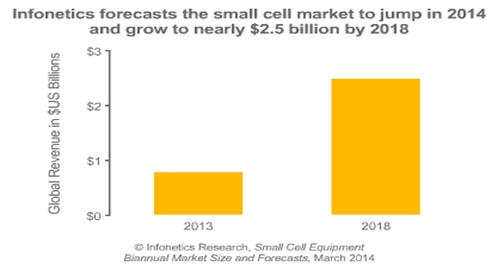 アナリストノート
「当社が予想したとおり、業界内の多くが望んでいたスモールセル設置の大幅な増大は2013年には見られませんでした。試験的な導入は引き続き堅調に推移しましたが、実際の設置はささやかなものでした。昨年のスモールセルの売上はわずか7億7100万ドルです。2G/3G RAN市場が240億ドルであるのとは明確な対照を示しています」Infonetics Researchのモバイルインフラストラクチャおよびキャリア経済担当の主席アナリストであるStéphane Téralは語る。
アナリストノート
「当社が予想したとおり、業界内の多くが望んでいたスモールセル設置の大幅な増大は2013年には見られませんでした。試験的な導入は引き続き堅調に推移しましたが、実際の設置はささやかなものでした。昨年のスモールセルの売上はわずか7億7100万ドルです。2G/3G RAN市場が240億ドルであるのとは明確な対照を示しています」Infonetics Researchのモバイルインフラストラクチャおよびキャリア経済担当の主席アナリストであるStéphane Téralは語る。Infoneticsのモバイルバックホールおよびスモールセル担当ディレクティングアナリストで、レポートの共同執筆者でもあるRichard Webbは、次のようにつけ加える。「とはいえ、一定レベルのモバイルブロードバンドエクスペリエンスを維持するのに悪戦苦闘している現状からは飽和した既存のマクロセルネットワークを強化する必要性があり、また、既存のLTEネットワークの能力を高める必要も認められることから、当社の予測はいくらか引き上げられました。結果的に、当社はスモールセル市場は年末までに65%拡大し、13億ドル規模に達すると予測しました」 スモールセル市場のハイライト
- 携帯電話事業者はスモールセルの考慮以前に、まずはデータトラフィックの「クリティカルマス」に近づく必要がある。早期の導入に積極的に取り組んでいるのは先進国 (日本、韓国、イギリス、アメリカ) である。
- 2013年のスモールセルユニット設置数は642,000であり、2012年比で143パーセントの急騰を見た。設置されたユニットの半数以上は3G用のものである。
- しかしながら、今年以降、4Gメトロセルが3Gとの差を縮め、成長の主要なエンジンになると見られる。
- 現在ではバックホールはスモールセル設置拡大の主要な阻害理由ではなくなったが、一部の携帯電話事業者ではその営業地域の地理的特性のために依然として問題であり続けている。
- スモールセルで完全に機能する5Gの到来が近づいている。日本のNTTドコモは、東京オリンピックに間に合うように、2020年に5Gの商業利用を開始する計画でいる。
Small cell market on track to increase 65% this year Campbell, CALIFORNIA, April 28, 2014-Telecom market research firm Infonetics Research released excerpts from its latest Small Cell Equipment market size and forecast report, which tracks 3G microcells, picocells, and metrocells and LTE mini eNodeBs and metrocells. ANALYST NOTE "As we anticipated, the great small cell ramp did not happen in 2013 as many in the industry had hoped. Testing activity remained solid, but actual deployments were modest. Small cell revenue was just $771 million last year, a sharp contrast to the $24 billion 2G/3G RAN market," reports Stéphane Téral, principal analyst for mobile infrastructure and carrier economics at Infonetics Research.
Richard Webb, directing analyst for mobile backhaul and small cells at Infonetics and co-author of the report, adds: "Nevertheless, the need to enhance existing saturated macrocellular networks that are struggling to maintain a decent mobile broadband experience, as well as to add capacity to existing LTE networks, is bringing some fuel to our forecast and, consequently, we expect the small cell market to grow 65% by year's end, when it will reach $1.3 billion.". SMALL CELL MARKET HIGHLIGHTS
- As mobile operators have to approach a "critical mass" of data traffic before small cells even become a consideration, it is the developed countries (Japan, South Korea, the UK and US) that are driving early adoption
- 642,000 small cell units shipped in 2013, a 143% spike from 2012; over half of these units are of the 3G variety
- However, starting this year, 4G metrocells will close the gap with 3G, becoming the main growth engine
- Backhaul is no longer a major inhibitor to small cell deployment, but it will remain an issue for some mobile operators due to the locations in which they operate
- 5G is coming, fully loaded with small cells: NTT DOCOMO in Japan plans to have 5G commercially available in 2020, in time for the Tokyo Olympics

